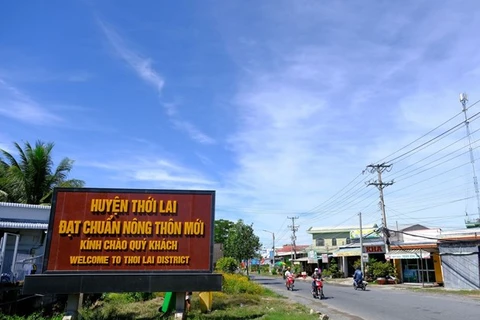 Youth union members and residents in HCM City’s District 9 work together to clean city streets. (Photo nhandan.com.vn)
Youth union members and residents in HCM City’s District 9 work together to clean city streets. (Photo nhandan.com.vn) HCM City (VNS/VNA) — HCM City has reached 12 of its 16 targets in its pollution reduction programme for the 2016-20 period, according to the city’s Department of Natural Resources and Environment.
With the largest population in the country, the city is the nation’s economic locomotive but is facing many challenges, including pollution. About 1,300 factories in 18 industrial parks and 3,000 small- and large-scale production establishments outside industrial parks operate in the city.
Despite this, the city had achieved positive changes in environmental protection activities, Nguyen Toan Thang, department director, said.
Under the five-year programme, the city is focusing on preventing air pollution and managing air quality as well as surface water, ground water and waste.
The city regularly dredges and collects waste, water hyacinth and wild grass, helping clear the flow of water and improve hygiene.
Authorities also strictly punish anyone who dumps rubbish in unauthorised areas such as sidewalks, roads or the drainage system.
The number of industrial establishments treating discharged wastewater has increased to 97 percent from 85 percent, with 99 percent of the total volume of wastewater treated.
Ninety-eight percent of industrial establishments invest in a gas treatment system or use clean fuels (electricity, Diesel Oil and compressed natural gas). And all hospitals in the city have set up wastewater treatment systems.
The rate of renewable energy usage has reached about 1.8 percent, more than 0.06 percent in excess of the target for the period.
Software is also being used to keep track of violations concerning urban order, raising the rate of resolved complaints.
“Making people more aware of classifying garbage at source has been one of the significant breakthroughs in this period,” Thang said.
Residents have reduced their use of plastic bags and changed their habits by using more environmentally friendly products.
The city has built and put into operation three new plants using advanced technologies that generate electricity from waste.
Solid waste collection, transportation and treatment have been done in a timely fashion, and have eliminated the waste backlog situation.
“Many pollution hot spots in the city have been resolved completely,” Thang said.
The city has reduced 715 of the 747 waste backlog locations causing environmental pollution, reaching 95.7 percent of all of these areas.
It has also installed additional 34,000 rubbish bins and 28,000 surveillance cameras to detect violations relating to littering in public./.
VNA























